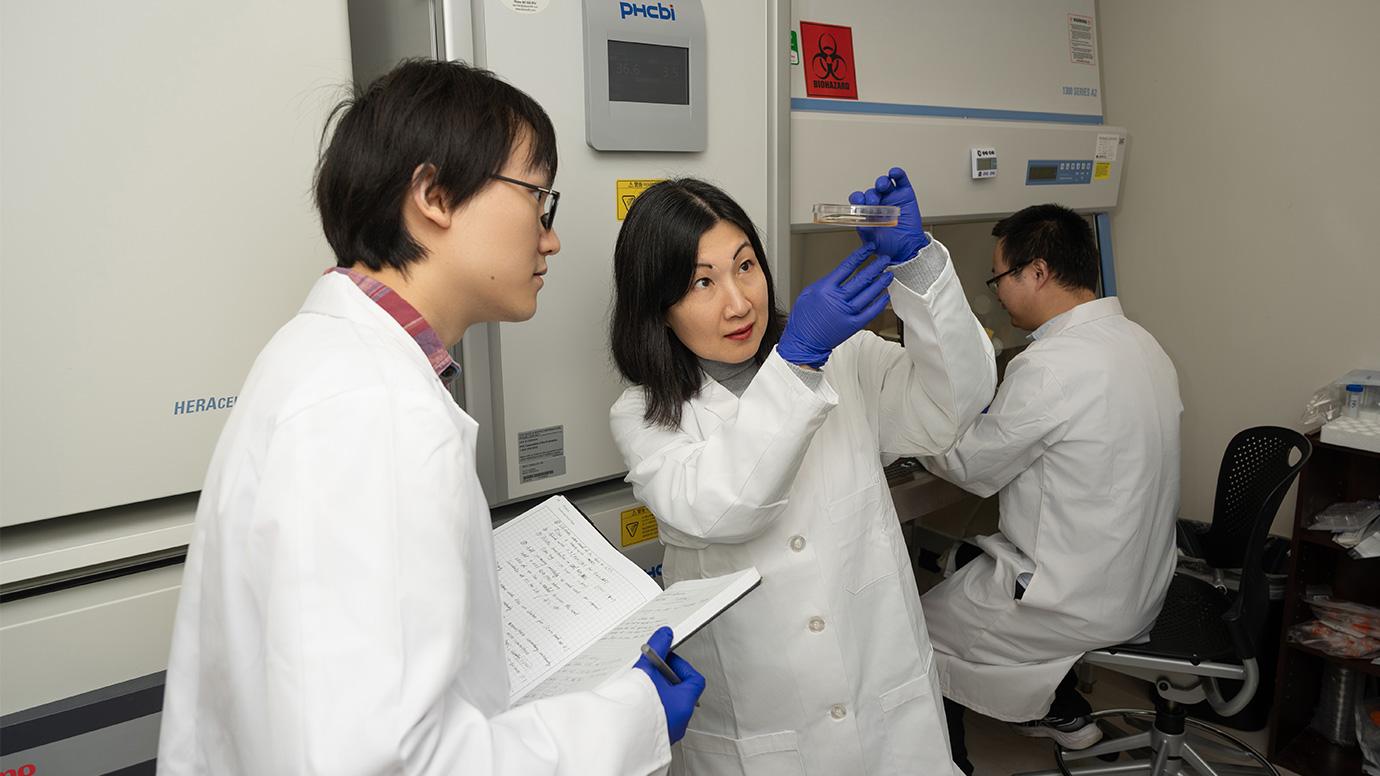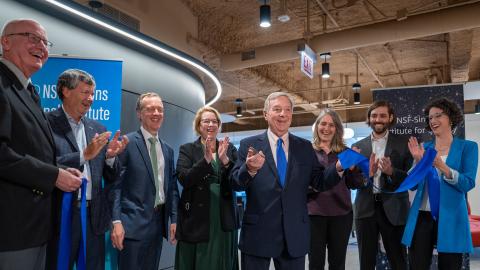Editor’s Note: This is part of a series called Inside the Lab, which gives audiences a first-hand look at the laboratories of researchers at the University of Chicago who are working to improve our world. Read more about the series here.
Discover more from this series:
Neat rows of lab benches and gently humming freezers line the laboratory walls of Joyce Chen, an assistant professor at the University of Chicago’s Pritzker School of Molecular Engineering and Ben May Department for Cancer Research.
There, her team of scientists are finding innovative ways to grow lung cells and structures inside the laboratory. This helps us understand the many tiny changes that take place in your lungs when disease strikes—and thus find new ways to treat diseases and protect lung health.
To learn more, we spoke with Chen and two members of her lab: Ph.D student Shuang Wu and postdoctoral researcher Shuya Mei.

Why is it important to study lung disease?
Chen: The lungs are one of the very few organs that are directly connected to the outside environment, so they are uniquely vulnerable. They are exposed to the air, to the atmosphere, and they have very suitable conditions for microbes: warm temperatures and ample blood supply. So there are many threats—pathogens like viruses, bacteria, or fungi, as well as pollution and smoking. In my lab, we are particularly interested in studying both genetic diseases like cancer and also infectious disease.
What makes studying disease in the lungs so hard?
Chen: Lung structures are so beautiful, but yet so complex. Because of these complexities, diseases can happen in different locations of the lung system, and we have to apply different strategies to study each of them. It also means that recreating tissue or cell systems to study lung cancer in the lab is relatively challenging compared to other organs.
So one of the main directions in my lab is to be able to grow miniature human lung tissue and systems in the lab to study them. We want to create multicellular structures that mimic different parts of the lungs, and to study how these complex systems, including the immune system, the pathogens, and disease cells interact. It is also important to be able to test new therapies in a structure that behaves like a real lung.
How do you recreate a lung structure in the lab?
Chen: We work with a type of stem cell called a pluripotent stem cell, which can convert themselves into other kinds of cells as needed. In 2012, a group led by Dr. Shin Yamanaka received a Nobel Prize for finding a way to make pluripotent stem cells from adult cells, so you don’t need embryonic stem cells. With this technology, known as iPSC, you could take any cell from your body and convert it into any other kind of cell.
We use this technique in our lab. We are very pleased with the results—we showed that we can generate any of the major cell types found in the lining of the human airway, called the epithelium. We can make these mini-tissues in unlimited amounts in culture dishes. We can even grow them into small 3D structures, what we call “organoids,” which is more similar to how they would grow in a person than a simple flat layer. And then we can study the interaction between these host cells and other types of cells, or with pathogens, or toxins.
We can make all of these structures from a few cells from any individual person.

What does a typical day in the lab look like?
Wu: Right now I’m working on a project to understand how fungus affects the lungs. When you breathe, tons of microorganisms including fungal cells go into your airways; we want to learn how fungus interacts with normal lung cells and also cancerous cells. Does fungus cause DNA damage that potentially leads to cancer? If you already have cancer, does fungus suppress or promote cancer growth? So I take petri dishes and grow human lung cells and fungus together. Then I will run various tests to see what is happening inside the lung cells. For example, I can look at the DNA to see if there is damage, or I can look at the RNA to see if the cell is producing proteins to respond to infection.
Mei: My project involves growing these lung structures in petri dishes, so it’s taking care of these cells as they grow. We change out the growth medium every other day—meaning that someone needs to come to the lab on the weekends and on holidays. And you have to add the right growth factors each time. It’s not difficult, but it takes patience and care.
"Recreating tissue or cell systems to study lung cancer in the lab is relatively challenging compared to other organs."
What do you hope your work will lead to?
Wu: Cancer therapies have been studied for decades, but we think there is a piece of the puzzle missing, which is the crosstalk between microorganisms, especially fungi and the tumor. This is partly because it’s difficult to culture fungus, and partly because previously there weren’t proper human-derived ex vivo models (instead of mice). So we are hoping to push the field forward and learn more about fungus and human lungs.
Mei: I’m a doctor in China. My area is intensive care, and we take care of so many people with lung injuries—from viruses, bacteria, fungi and pollution. I am working to become a researcher as well because I am hoping we can find information that leads to new treatment options for these patients.
Gallery: Inside the Chen lab 1/4
What kind of special instruments or equipment do you use?
Wu: Right now I’m doing a lot of flow cytometry. This is a technique that gives you information about what is going on inside cells, such as which proteins the cells are producing more or less of in response to various situations. There’s a long procedure, from the cell culture to the treatment; I then will harvest the cells from my petri dish, apply a special stain which involves several steps of adding chemicals and washing them, and then bring them to the flow cytometer machine.
What’s the most challenging part of the work?
Wu: Sometimes, the most frustrating moments occur when you expect outcome A in your experiment but observe B or even C instead. When this happens, it prompts you to consider whether adjustments need to be made to your procedure or experimental setup. However, these unexpected results can also lead to intriguing new questions and potentially shift your perspective. Thus, what starts as frustration can sometimes turn into excitement. This dynamic encapsulates the complexity and allure of biology.
Chen: The things we study are very difficult to study. For example, small-cell lung cancer is one of the most aggressive types of cancer in the human body; there hasn’t been as much research progress in the past two or three decades, in part because it’s so problematic to study. But we have had a few breakthroughs that make us hopeful that we can make some real progress—being able to watch how the disease proceeds over time in a way that is impossible in a human patient—against a recalcitrant disease.














